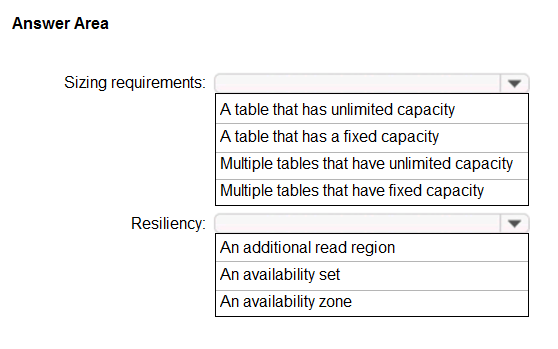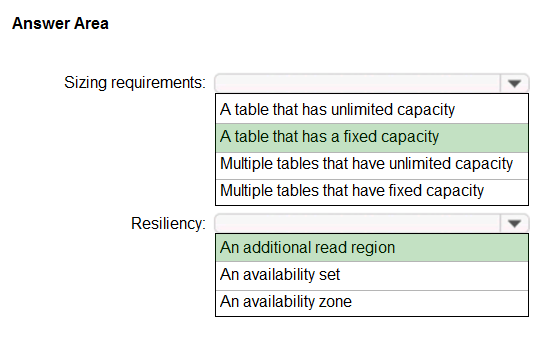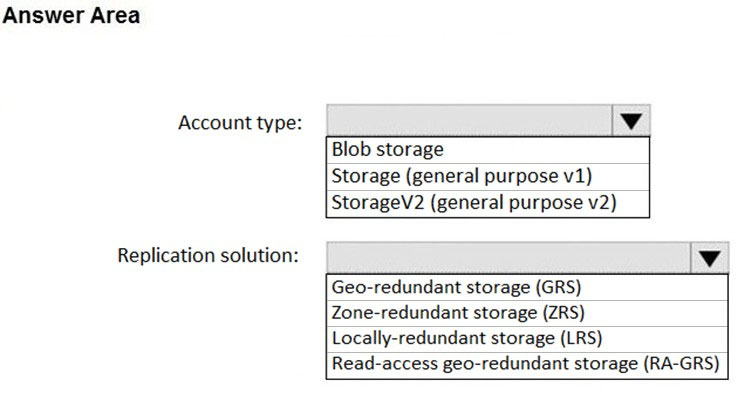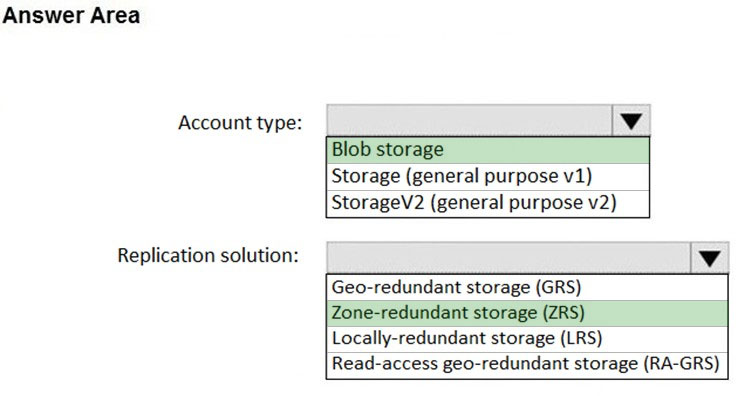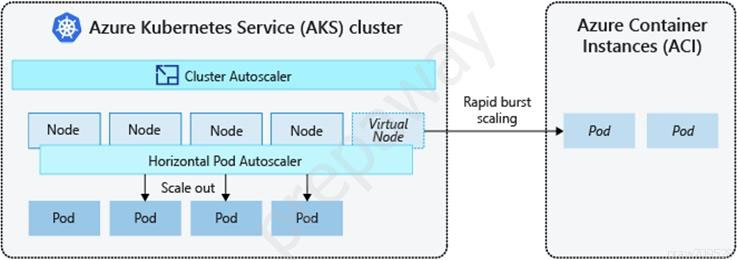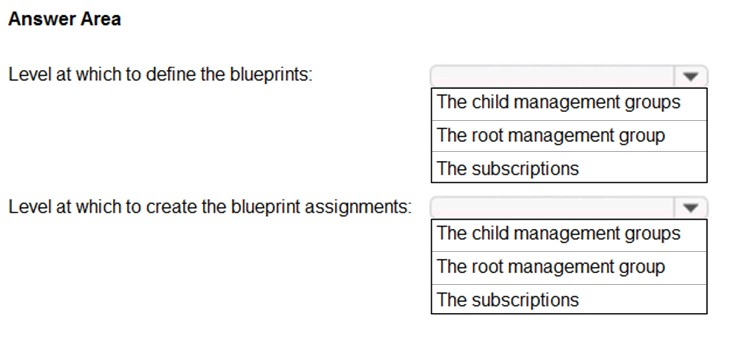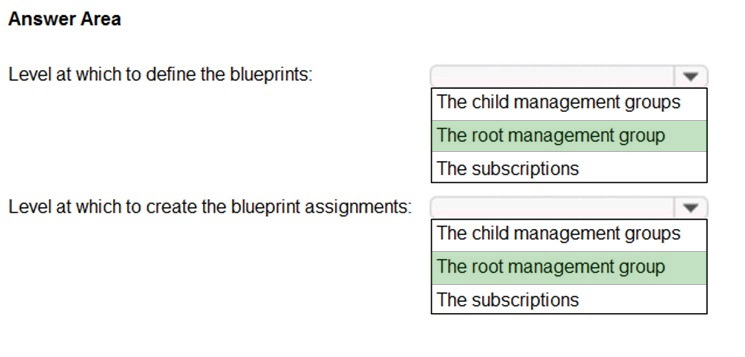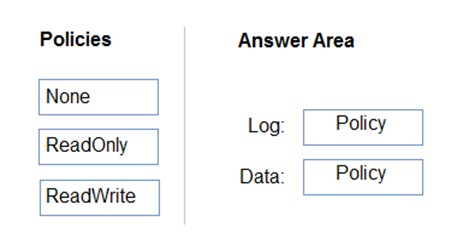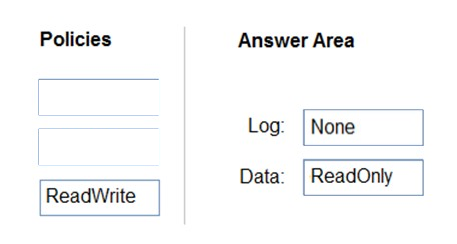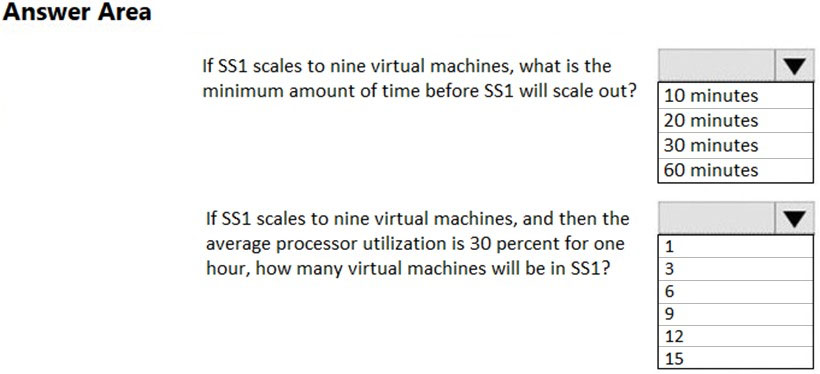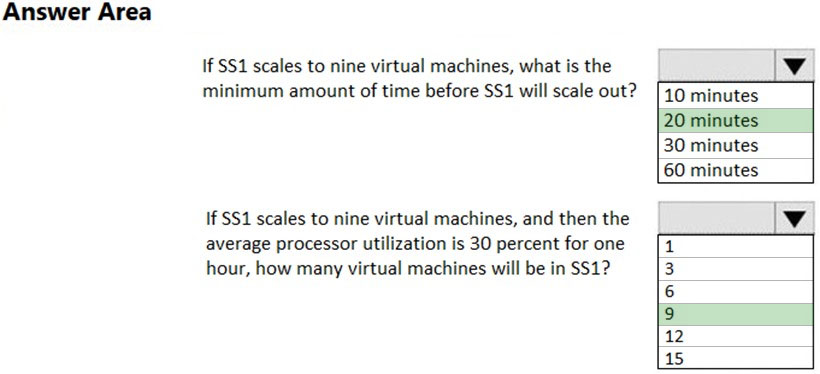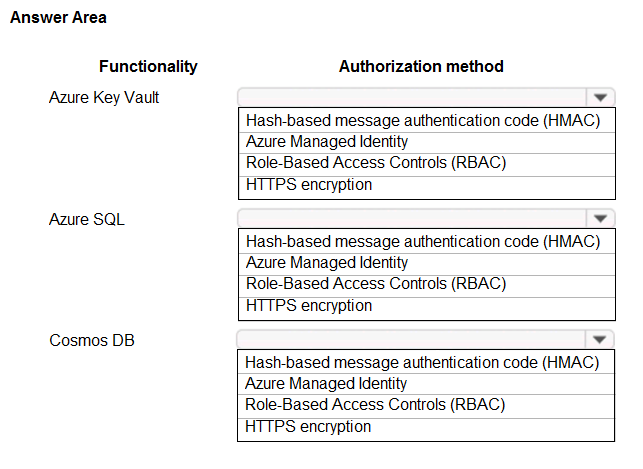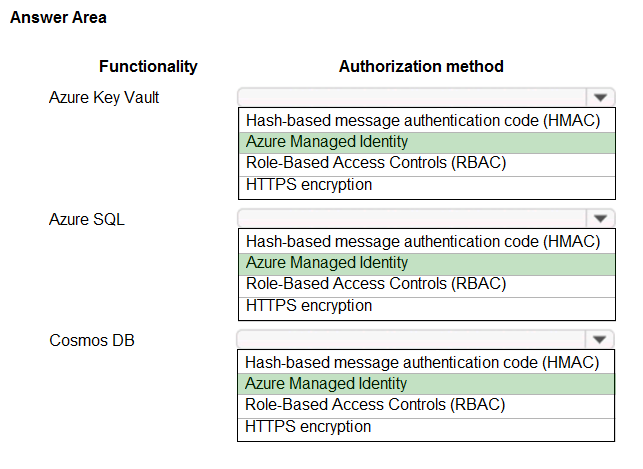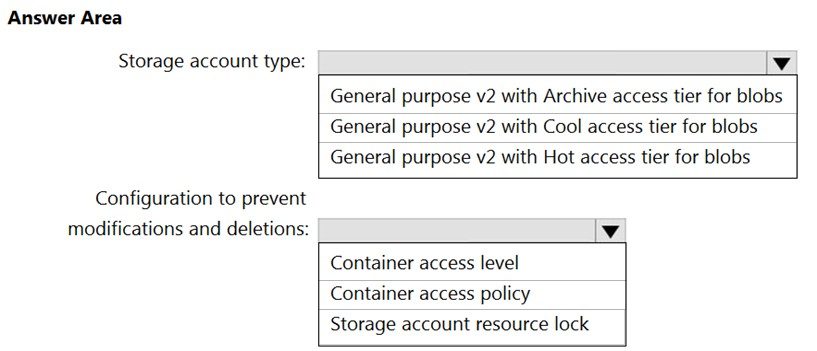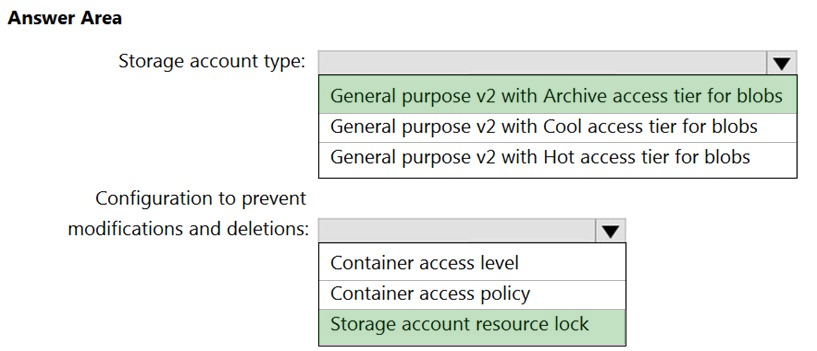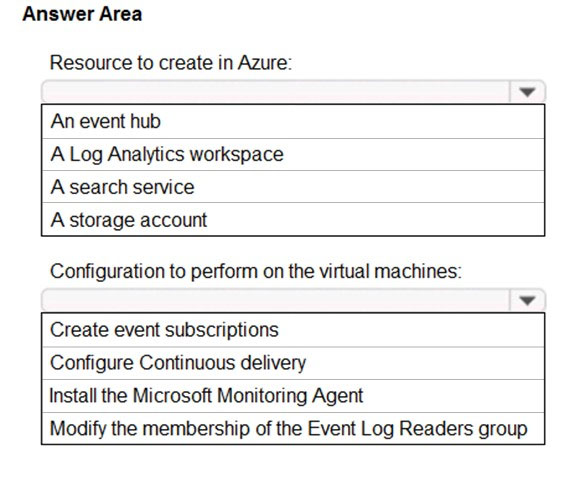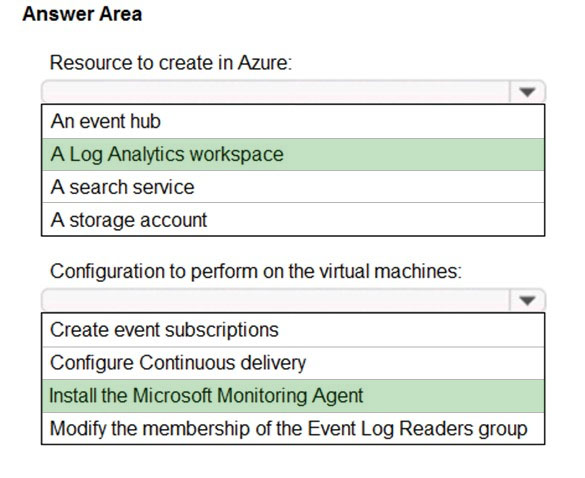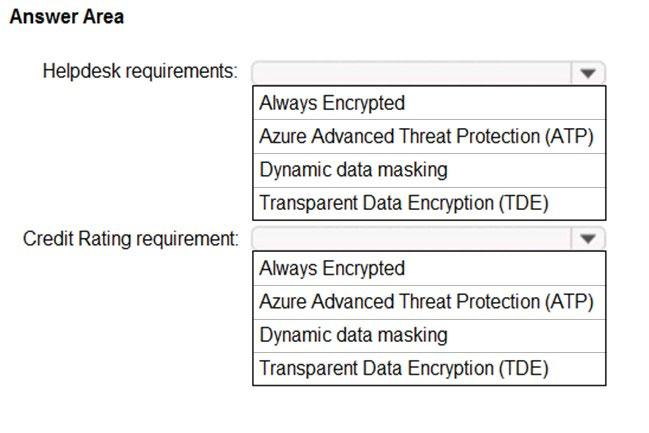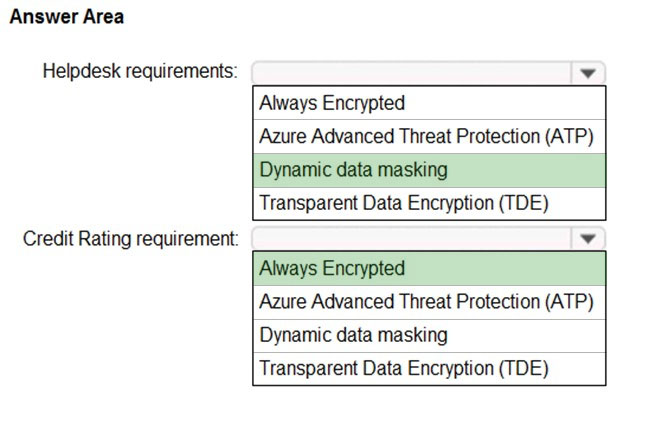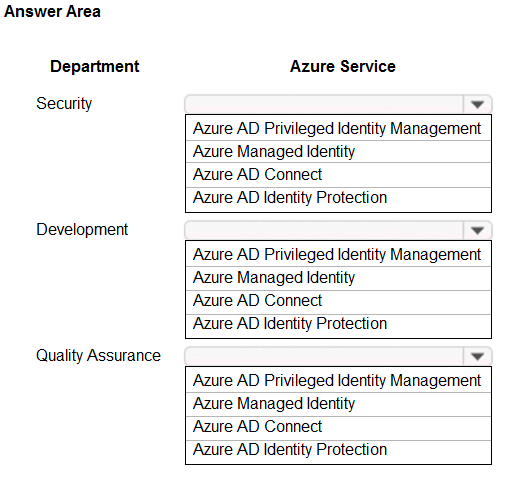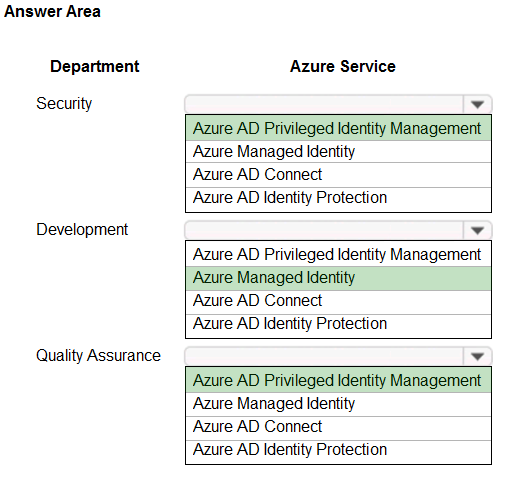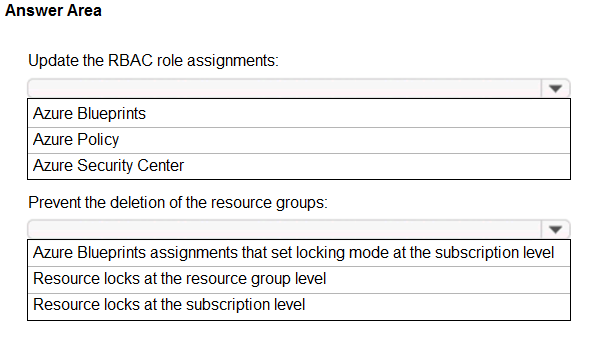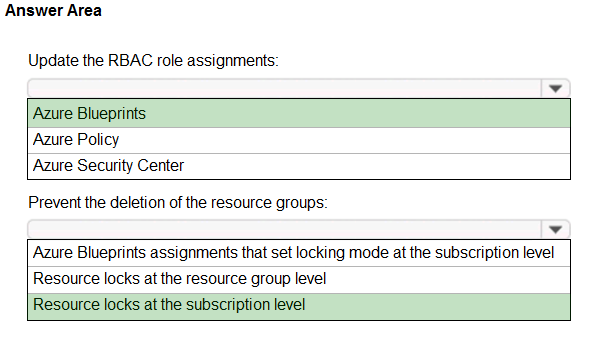AZ-304 Exam Prep Free – 50 Practice Questions to Get You Ready for Exam Day
Getting ready for the AZ-304 certification? Our AZ-304 Exam Prep Free resource includes 50 exam-style questions designed to help you practice effectively and feel confident on test day
Effective AZ-304 exam prep free is the key to success. With our free practice questions, you can:
- Get familiar with exam format and question style
- Identify which topics you’ve mastered—and which need more review
- Boost your confidence and reduce exam anxiety
Below, you will find 50 realistic AZ-304 Exam Prep Free questions that cover key exam topics. These questions are designed to reflect the structure and challenge level of the actual exam, making them perfect for your study routine.
HOTSPOT - You need to recommend a solution for the data store of the historical transaction query system. What should you include in the recommendation? To answer, select the appropriate options in the answer area. NOTE: Each correct selection is worth one point. Hot Area:
You have an Azure subscription. You need to recommend a solution to provide developers with the ability to provision Azure virtual machines. The solution must meet the following requirements: ✑ Only allow the creation of the virtual machines in specific regions. ✑ Only allow the creation of specific sizes of virtual machines. What should you include in the recommendation?
A. Azure Resource Manager templates
B. Azure Policy
C. conditional access policies
D. role-based access control (RBAC)
After you answer a question in this section, you will NOT be able to return to it. As a result, these questions will not appear in the review screen. Your company has an on-premises Active Directory Domain Services (AD DS) domain and an established Azure Active Directory (Azure AD) environment. Your company would like users to be automatically signed in to cloud apps when they are on their corporate desktops that are connected to the corporate network. You need to enable single sign-on (SSO) for company users. Solution: Install and configure an Azure AD Connect server to use password hash synchronization and select the `Enable single sign-on` option. Does the solution meet the goal?
A. Yes
B. No
HOTSPOT - You have an on-premises file server that stores 2 TB of data files. You plan to move the data files to Azure Blob storage in the Central Europe region. You need to recommend a storage account type to store the data files and a replication solution for the storage account. The solution must meet the following requirements: ✑ Be available if a single Azure datacenter fails. ✑ Support storage tiers. ✑ Minimize cost. What should you recommend? To answer, select the appropriate options in the answer area. NOTE: Each correct selection is worth one point. Hot Area:
Your company plans to publish APIs for its services by using Azure API Management. You discover that service responses include the AspNet-Version header. You need to recommend a solution to remove AspNet-Version from the response of the published APIs. What should you include in the recommendation?
A. a new product
B. a modification to the URL scheme
C. a new policy
A company has a hybrid ASP.NET Web API application that is based on a software as a service (SaaS) offering. Users report general issues with the data. You advise the company to implement live monitoring and use ad hoc queries on stored JSON data. You also advise the company to set up smart alerting to detect anomalies in the data. You need to recommend a solution to set up smart alerting. What should you recommend?
A. Azure Site Recovery and Azure Monitor Logs
B. Azure Data Lake Analytics and Azure Monitor Logs
C. Azure Application Insights and Azure Monitor Logs
D. Azure Security Center and Azure Data Lake Store
You are designing an order processing system in Azure that will contain the Azure resources shown in the following table.The order processing system will have the following transaction flow: ✑ A customer will place an order by using App1. ✑ When the order is received, App1 will generate a message to check for product availability at vendor 1 and vendor 2. ✑ An integration component will process the message, and then trigger either Function1 or Function2 depending on the type of order. ✑ Once a vendor confirms the product availability, a status message for App1 will be generated by Function1 or Function2. ✑ All the steps of the transaction will be logged to storage1. Which type of resource should you recommend for the integration component?
A. an Azure Data Factory pipeline
B. an Azure Service Bus queue
C. an Azure Event Grid domain
D. an Azure Event Hubs capture
HOTSPOT - You have an Azure Active Directory (Azure AD) tenant. You plan to use Azure Monitor to monitor user sign-ins and generate alerts based on specific user sign-in events. You need to recommend a solution to trigger the alerts based on the events. What should you include in the recommendation? To answer, select the appropriate options in the answer area. NOTE: Each correct selection is worth one point. Hot Area:
Your network contains an on-premises Active Directory domain. The domain contains the Hyper-V clusters shown in the following table.You plan to implement Azure Site Recovery to protect six virtual machines running on Cluster1 and three virtual machines running on Cluster2. Virtual machines are running on all Cluster1 and Cluster2 nodes. You need to identify the minimum number of Azure Site Recovery Providers that must be installed on premises. How many Providers should you identify?
A. 1
B. 7
C. 9
D. 16
You have data files in Azure Blob storage. You plan to transform the files and move them to Azure Data Lake Storage. You need to transform the data by using mapping data flow. Which Azure service should you use?
A. Azure Data Box Gateway
B. Azure Storage Sync
C. Azure Data Factory
D. Azure Databricks
After you answer a question in this section, you will NOT be able to return to it. As a result, these questions will not appear in the review screen. You have an Azure Storage v2 account named storage1. You plan to archive data to storage1. You need to ensure that the archived data cannot be deleted for five years. The solution must prevent administrators from deleting the data. Solution: You create a file share, and you configure an access policy. Does this meet the goal?
A. Yes
B. No
You are designing a microservices architecture that will be hosted in an Azure Kubernetes Service (AKS) cluster. Apps that will consume the microservices will be hosted on Azure virtual machines. The virtual machines and the AKS cluster will reside on the same virtual network. You need to design a solution to expose the microservices to the consumer apps. The solution must meet the following requirements: ✑ Ingress access to the microservices must be restricted to a single private IP address and protected by using mutual TLS authentication. ✑ The number of incoming microservice calls must be rate-limited. ✑ Costs must be minimized. What should you include in the solution?
A. Azure App Gateway with Azure Web Application Firewall (WAF)
B. Azure API Management Premium tier with virtual network connection
C. Azure API Management Standard tier with a service endpoint
D. Azure Front Door with Azure Web Application Firewall (WAF)
You need to recommend a backup solution for the data store of the payment processing system. What should you include in the recommendation?
A. Microsoft System Center Data Protection Manager (DPM)
B. Azure Backup Server
C. Azure SQL long-term backup retention
D. Azure Managed Disks
You have an Azure subscription. You need to deploy an Azure Kubernetes Service (AKS) solution that will use Windows Server 2019 nodes. The solution must meet the following requirements: ✑ Minimize the time it takes to provision compute resources during scale-out operations. ✑ Support autoscaling of Windows Server containers. Which scaling option should you recommend?
A. cluster autoscaler
B. horizontal pod autoscaler
C. Kubernetes version 1.20.2 or newer
D. Virtual nodes with Virtual Kubelet ACI
You need to recommend a compute solution for the middle tier of the payment processing system. What should you include in the recommendation?
A. virtual machine scale sets
B. availability sets
C. Azure Kubernetes Service (AKS)
D. Function App
You have an Azure Active Directory (Azure AD) tenant and Windows 10 devices. You configure a conditional access policy as shown in the exhibit. (Click the Exhibit tab.)What is the result of the policy?
A. All users will always be prompted for multi-factor authentication (MFA).
B. Users will be prompted for multi-factor authentication (MFA) only when they sign in from devices that are NOT joined to Azure AD.
C. All users will be able to sign in without using multi-factor authentication (MFA).
D. Users will be prompted for multi-factor authentication (MFA) only when they sign in from devices that are joined to Azure AD.
You architect a solution that calculates 3D geometry from height-map data. You have the following requirements: Perform calculations in Azure.✑ Each node must communicate data to every other node. ✑ Maximize the number of nodes to calculate multiple scenes as fast as possible. ✑ Require the least amount of effort to implement. You need to recommend a solution. Which two actions should you recommend? Each correct answer presents part of the solution. NOTE: Each correct selection is worth one point.
A. Create a render farm that uses Azure Batch.
B. Create a render farm that uses virtual machines (VMs).
C. Enable parallel task execution on compute nodes.
D. Create a render farm that uses virtual machine (VM) scale sets.
E. Enable parallel file systems on Azure.
HOTSPOT - You plan to create an Azure environment that will contain a root management group and 10 child management groups. Each child management group will contain five Azure subscriptions. You plan to have between 10 and 30 resource groups in each subscription. You need to design an Azure governance solution. The solution must meet the following requirements: ✑ Use Azure Blueprints to control governance across all the subscriptions and resource groups. ✑ Ensure that Blueprints-based configurations are consistent across all the subscriptions and resource groups. ✑ Minimize the number of blueprint definitions and assignments. What should you include in the solution? To answer, select the appropriate options in the answer area. NOTE: Each correct selection is worth one point. Hot Area:
You are designing an Azure resource deployment that will use Azure Resource Manager templates. The deployment will use Azure Key Vault to store secrets. You need to recommend a solution to meet the following requirements: ✑ Prevent the IT staff that will perform the deployment from retrieving the secrets directly from Key Vault. ✑ Use the principle of least privilege. Which two actions should you recommend? Each correct answer presents part of the solution. NOTE: Each correct selection is worth one point.
A. Create a Key Vault access policy that allows all get key permissions, get secret permissions, and get certificate permissions.
B. From Access policies in Key Vault, enable access to the Azure Resource Manager for template deployment.
C. Create a Key Vault access policy that allows all list key permissions, list secret permissions, and list certificate permissions.
D. Assign the IT staff a custom role that includes the Microsoft.KeyVault/Vaults/Deploy/Action permission.
E. Assign the Key Vault Contributor role to the IT staff.
Your company has offices in the United States, Europe, Asia, and Australia. You have an on-premises app named App1 that uses Azure Table storage. Each office hosts a local instance of App1. You need to upgrade the storage for App1. The solution must meet the following requirements: ✑ Enable simultaneous write operations in multiple Azure regions. ✑ Ensure that write latency is less than 10 ms. ✑ Support indexing on all columns. Minimize development effort.Which data platform should you use?
A. Azure SQL Database
B. Azure SQL Managed Instance
C. Azure Cosmos DB
D. Table storage that uses geo-zone-redundant storage (GZRS) replication
After you answer a question in this section, you will NOT be able to return to it. As a result, these questions will not appear in the review screen. You plan to deploy multiple instances of an Azure web app across several Azure regions. You need to design an access solution for the app. The solution must meet the following replication requirements: ✑ Support rate limiting. ✑ Balance requests between all instances. Ensure that users can access the app in the event of a regional outage.Solution: You use Azure Load Balancer to provide access to the app. Does this meet the goal?
A. Yes
B. No
The accounting department at your company migrates to a new financial accounting software. The accounting department must keep file-based database backups for seven years for compliance purposes. It is unlikely that the backups will be used to recover data. You need to move the backups to Azure. The solution must minimize costs. Where should you store the backups?
A. Azure Blob storage that uses the Archive tier
B. Azure SQL Database
C. Azure Blob storage that uses the Cool tier
D. a Recovery Services vault
You have an Azure subscription. You need to deploy an Azure Kubernetes Service (AKS) solution that will use Linux nodes. The solution must meet the following requirements: ✑ Minimize the time it takes to provision compute resources during scale-out operations. ✑ Support autoscaling of Linux containers. ✑ Minimize administrative effort. Which scaling option should you recommend?
A. Virtual Kubelet
B. cluster autoscaler
C. horizontal pod autoscaler
D. AKS virtual nodes
A company deploys Azure Active Directory (Azure AD) Connect to synchronize identity information from their on-premises Active Directory Domain Services (AD DS) directory to their Azure AD tenant. The identity information that is synchronized includes user accounts, credential hashes for authentication (password sync), and group memberships. The company plans to deploy several Windows and Linux virtual machines (VMs) to support their applications. The VMs have the following requirements: ✑ Support domain join, LDAP read, LDAP bind, NTLM and Kerberos authentication, and Group Policy. ✑ Allow users to sign in to the domain using their corporate credentials and connect remotely to the VM by using Remote Desktop. You need to support the VM deployment. Which service should you use?
A. Active Directory Federation Services (AD FS)
B. Azure AD Privileged Identity Management
C. Azure Managed Identity
D. Azure AD Domain Services
DRAG DROP - You are designing a virtual machine that will run Microsoft SQL Server and will contain two data disks. The first data disk will store log files, and the second data disk will store data. Both disks are P40 managed disks. You need to recommend a caching policy for each disk. The policy must provide the best overall performance for the virtual machine while preserving integrity of the SQL data and logs. Which caching policy should you recommend for each disk? To answer, drag the appropriate policies to the correct disks. Each policy may be used once, more than once, or not at all. You may need to drag the split bar between panes or scroll to view content. Select and Place:
Your company purchases an app named App1. You plan to run App1 on seven Azure virtual machines in an Availability Set. The number of fault domains is set to 3. The number of update domains is set to 20. You need to identify how many App1 instances will remain available during a period of planned maintenance. How many App1 instances should you identify?
A. 1
B. 2
C. 6
D. 7
HOTSPOT - You have a virtual machine scale set named SS1. You configure autoscaling as shown in the following exhibit.You configure the scale out and scale in rules to have a duration of 10 minutes and a cool down time of 10 minutes. Use the drop-down menus to select the answer choice that answers each question based on the information presented in the graphic. NOTE: Each correct selection is worth one point. Hot Area:
You need to recommend a notification solution for the IT Support distribution group. What should you include in the recommendation?
A. a SendGrid account with advanced reporting
B. Azure AD Connect Health
C. Azure Network Watcher
D. an action group
DRAG DROP - You have an on-premises network that uses an IP address space of 172.16.0.0/16. You plan to deploy 25 virtual machines to a new Azure subscription. You identify the following technical requirements: ✑ All Azure virtual machines must be placed on the same subnet named Subnet1. ✑ All the Azure virtual machines must be able to communicate with all on-premises servers. ✑ The servers must be able to communicate between the on-premises network and Azure by using a site-to-site VPN. You need to recommend a subnet design that meets the technical requirements. What should you include in the recommendation? To answer, drag the appropriate network addresses to the correct subnets. Each network address may be used once, more than once, or not at all. You may need to drag the split bar between panes or scroll to view content. NOTE: Each correct selection is worth one point. Select and Place:
You plan to create an Azure Cosmos DB account that uses the SQL API. The account will contain data added by a web application. The web application will send data daily. You need to recommend a notification solution that meets the following requirements: ✑ Sends email notifications when data is received from the web application ✑ Minimizes compute cost What should you include in the recommendation?
A. Deploy an Azure logic app that has a SendGrid connector configured to use an Azure Cosmos DB action.
B. Deploy a function app that is configured to use the Consumption plan and an Azure Event Hubs binding.
C. Deploy a function app that is configured to use the Consumption plan and a SendGrid binding.
D. Deploy an Azure logic app that has a webhook configured to use a SendGrid action.
You need to recommend a data storage strategy for WebApp1. What should you include in the recommendation?
A. a vCore-based Azure SQL database
B. an Azure virtual machine that runs SQL Server
C. an Azure SQL Database elastic pool
D. a fixed-size DTU Azure SQL database
You need to recommend a disaster recovery solution for the back-end tier of the payment processing system. What should you include in the recommendation?
A. Azure Site Recovery
B. an auto-failover group
C. Always On Failover Cluster Instances
D. geo-redundant database backups
HOTSPOT - You are building an application that will run in a virtual machine (VM). The application will use Azure Managed Identity. The application uses Azure Key Vault, Azure SQL Database, and Azure Cosmos DB. You need to ensure the application can use secure credentials to access these services. Which authorization method should you recommend? To answer, select the appropriate options in the answer area. NOTE: Each correct selection is worth one point. Hot Area:
You need to design a highly available Azure SQL database that meets the following requirements: ✑ Failover between replicas of the database must occur without any data loss. ✑ The database must remain available in the event of a zone outage. ✑ Costs must be minimized. Which deployment option should you use?
A. Azure SQL Database Standard
B. Azure SQL Database Serverless
C. Azure SQL Database Business Critical
D. Azure SQL Database Basic
You are designing a message application that will run on an on-premises Ubuntu virtual machine. The application will use Azure Storage queues. You need to recommend a processing solution for the application to interact with the storage queues. The solution must meet the following requirements: ✑ Create and delete queues daily. ✑ Be scheduled by using a CRON job. ✑ Upload messages every five minutes. What should developers use to interact with the queues?
A. Azure CLI
B. AzCopy
C. Azure Data Factory
D. .NET Core
You are developing a web application that provides streaming video to users. You configure the application to use continuous integration and deployment. The app must be highly available and provide a continuous streaming experience for users. You need to recommend a solution that allows the application to store data in a geographical location that is closest to the user. What should you recommend?
A. Azure Content Delivery Network (CDN)
B. Azure Redis Cache
C. Azure App Service Web Apps
D. Azure App Service Isolated
You need to recommend a solution to meet the database retention requirement. What should you recommend?
A. Configure geo-replication of the database.
B. Configure a long-term retention policy for the database.
C. Configure Azure Site Recovery.
D. Use automatic Azure SQL Database backups.
After you answer a question in this section, you will NOT be able to return to it. As a result, these questions will not appear in the review screen. Your company has deployed several virtual machines (VMs) on-premises and to Azure. Azure ExpressRoute has been deployed and configured for on-premises to Azure connectivity. Several VMs are exhibiting network connectivity issues. You need to analyze the network traffic to determine whether packets are being allowed or denied to the VMs. Solution: Use the Azure Traffic Analytics solution in Azure Log Analytics to analyze the network traffic. Does the solution meet the goal?
A. Yes
B. No
After you answer a question in this section, you will NOT be able to return to it. As a result, these questions will not appear in the review screen. You need to deploy resources to host a stateless web app in an Azure subscription. The solution must meet the following requirements: ✑ Provide access to the full .NET framework. ✑ Provide redundancy if an Azure region fails. ✑ Grant administrators access to the operating system to install custom application dependencies. Solution: You deploy a web app in an Isolated App Service plan. Does this meet the goal?
A. Yes
B. No
HOTSPOT - You are planning an Azure Storage solution for sensitive data. The data will be accessed daily. The data set is less than 10 GB. You need to recommend a storage solution that meets the following requirements: ✑ All the data written to storage must be retained for five years. ✑ Once the data is written, the data can only be read. Modifications and deletion must be prevented. ✑ After five years, the data can be deleted, but never modified. ✑ Data access charges must be minimized. What should you recommend? To answer, select the appropriate options in the answer area. NOTE: Each correct selection is worth one point. Hot Area:
After you answer a question in this section, you will NOT be able to return to it. As a result, these questions will not appear in the review screen. Your company has an on-premises Active Directory Domain Services (AD DS) domain and an established Azure Active Directory (Azure AD) environment. Your company would like users to be automatically signed in to cloud apps when they are on their corporate desktops that are connected to the corporate network. You need to enable single sign-on (SSO) for company users. Solution: Install and configure an Azure AD Connect server to use pass-through authentication and select the `Enable single sign-on` option. Does the solution meet the goal?
A. Yes
B. No
HOTSPOT - You have an Azure subscription that contains 300 Azure virtual machines that run Windows Server 2019. You need to centrally monitor all warning events in the System logs of the virtual machines. What should you include in the solution? To answer, select the appropriate options in the answer area. NOTE: Each correct selection is worth one point. Hot Area:
You plan to deploy an application that will run in a Linux-based Docker container. You need to recommend a solution to host the application in Azure. The solution must meet the following requirements: ✑ Support a custom domain name and an associated SSL certificate. ✑ Scale-out automatically based on demand. ✑ Minimize administrative effort and costs. What should you include in the recommendation?
A. Azure App Service
B. Azure Container Instances
C. an Azure virtual machine
D. Azure Kubernetes Service (AKS)
HOTSPOT - You have an Azure SQL database named DB1. You need to recommend a data security solution for DB1. The solution must meet the following requirements: ✑ When helpdesk supervisors query DB1, they must see the full number of each credit card. ✑ When helpdesk operators query DB1, they must see only the last four digits of each credit card number. ✑ A column named Credit Rating must never appear in plain text within the database system, and only client applications must be able to decrypt the Credit Rating column. What should you include in the recommendation? To answer, select the appropriate options in the answer area. NOTE: Each correct selection is worth one point. Hot Area:
After you answer a question in this section, you will NOT be able to return to it. As a result, these questions will not appear in the review screen. Your company has deployed several virtual machines (VMs) on-premises and to Azure. Azure ExpressRoute has been deployed and configured for on-premises to Azure connectivity. Several VMs are exhibiting network connectivity issues. You need to analyze the network traffic to determine whether packets are being allowed or denied to the VMs. Solution: Use Azure Network Watcher to run IP flow verify to analyze the network traffic. Does the solution meet the goal?
A. Yes
B. No
You have an on-premises network and an Azure subscription. The on-premises network has several branch offices. A branch office in Toronto contains a virtual machine named VM1 that is configured as a file server. Users access the shared files on VM1 from all the offices. You need to recommend a solution to ensure that the users can access the shared files as quickly as possible if the Toronto branch office is inaccessible. What should you include in the recommendation?
A. an Azure file share and Azure File Sync
B. a Recovery Services vault and Windows Server Backup
C. a Recovery Services vault and Azure Backup
D. Azure blob containers and Azure File Sync
HOTSPOT - Your organization has developed and deployed several Azure App Service Web and API applications. The applications use Azure Key Vault to store several authentication, storage account, and data encryption keys. Several departments have the following requests to support the applications:You need to recommend the appropriate Azure service for each department request. What should you recommend? To answer, configure the appropriate options in the dialog box in the answer area. NOTE: Each correct selection is worth one point. Hot Area:
You have 100 Microsoft SQL Server Integration Services (SSIS) packages that are configured to use 10 on-premises SQL Server databases as their destinations. You plan to migrate the 10 on-premises databases to Azure SQL Database. You need to recommend a solution to host the SSIS packages in Azure. The solution must ensure that the packages can target the SQL Database instances as their destinations. What should you include in the recommendation?
A. SQL Server Migration Assistant (SSMA)
B. Data Migration Assistant
C. Azure Data Catalog
D. Azure Data Factory
After you answer a question in this section, you will NOT be able to return to it. As a result, these questions will not appear in the review screen. You need to deploy resources to host a stateless web app in an Azure subscription. The solution must meet the following requirements: ✑ Provide access to the full .NET framework. ✑ Provide redundancy if an Azure region fails. ✑ Grant administrators access to the operating system to install custom application dependencies. Solution: You deploy two Azure virtual machines to two Azure regions, and you create a Traffic Manager profile. Does this meet the goal?
A. Yes
B. No
HOTSPOT - You plan to create an Azure environment that will have a root management group and five child management groups. Each child management group will contain five Azure subscriptions. You plan to have between 10 and 30 resource groups in each subscription. You need to design a solution for the planned environment. The solution must meet the following requirements: Prevent users who are assigned the Owner role for the subscriptions from deleting the resource groups from their respective subscription.✑ Ensure that you can update RBAC role assignments across all the subscriptions and resource groups. ✑ Minimize administrative effort. What should you include in the solution? To answer, select the appropriate options in the answer area. NOTE: Each correct selection is worth one point. Hot Area:
Access Full AZ-304 Exam Prep Free
Want to go beyond these 50 questions? Click here to unlock a full set of AZ-304 exam prep free questions covering every domain tested on the exam.
We continuously update our content to ensure you have the most current and effective prep materials.
Good luck with your AZ-304 certification journey!


